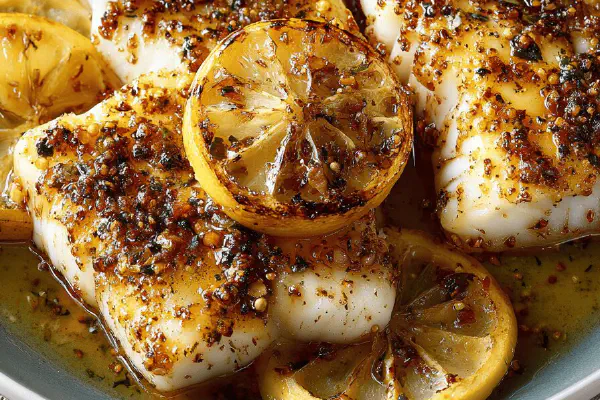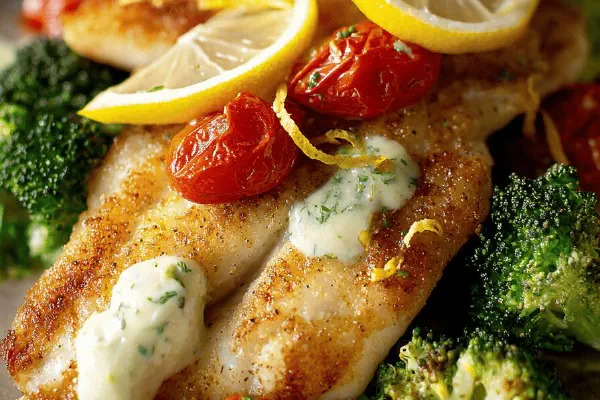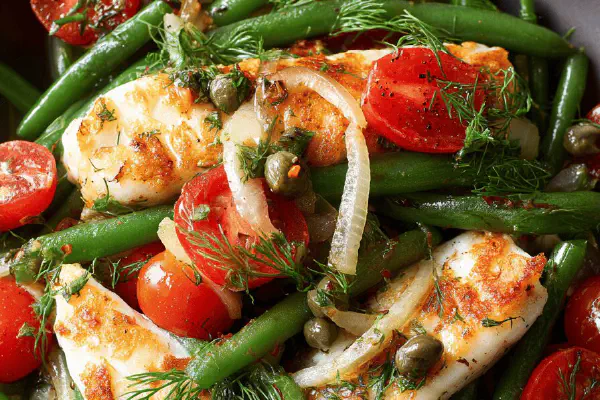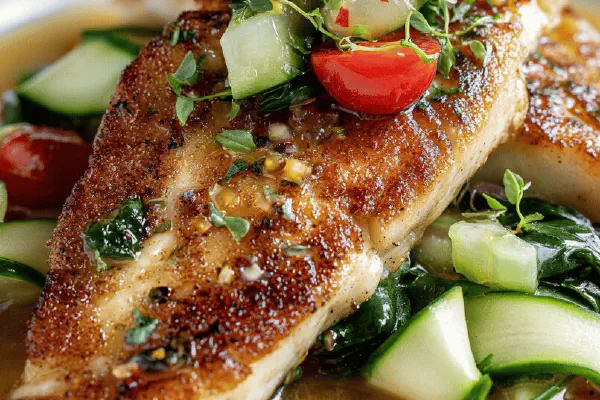Glazed Fish Dijon Twist

By Emma
Certified Culinary Professional
Ingredients
- 40 ml (2 2/3 tbsp) pure maple syrup
- 15 ml (1 tbsp) Dijon mustard
- 25 ml (5 tsp) whole grain mustard
- 4 skinless white fish fillets about 2.5 cm (1 inch) thick (cod, haddock, tilapia)
- 3 lemons, halved
- 30 ml (2 tbsp) olive oil
- Salt and freshly cracked black pepper
About the ingredients
Method
- Move oven rack near top, preheat broiler high. Fish thickness dictates broil time—thin cooks fast, keep watch.
- Whisk maple syrup with both mustards thoroughly. Sticky, grainy texture should cling well but not drip.
- Heat heavy skillet over medium-high, add olive oil swirling to coat. When hot, lay fish flat without crowding. Sear skinless side first until edges show opaque signs and bottom browns, about 3-4 minutes.
- Nestle lemon halves cut side down beside fish, let char and release oils, turn only if blackening too fast, about 5-6 minutes.
- Salt and pepper fish as you turn once. Remove pan from heat, brush thick coat of mustard-maple mixture on fish surfaces—glossy, generous layer.
- Slide skillet under broiler. Listen for sizzling, watch glaze bubble and caramelize into glossy crust. 3-6 minutes depending on thickness. Fish firms but still tender—use gentle press test, should spring back slightly.
- Serve immediately with grilled lemon halves for squeezing, rice or roasted vegetables for contrast.
- If no broiler, finish in 200°C (400°F) oven till glaze bubbles and fish flakes easily, about 10 minutes.
- Butter and honey can replace oil and maple if preferred, but prone to faster burning. Adjust broil timing down.
- If fillets too thin, reduce sear and broil times to avoid dryness. Rotate lemons to avoid bitterness from burnt skin.
Cooking tips
Chef's notes
- 💡 Heat pan thoroughly before adding fish; start sear skinless side good. Fish edges turn opaque as visual timer. Avoid overcrowding or steam. Texture should feel firm but springy. Use finger press test; mushy means undercooked, firm means overcooked. Timing varies with thickness; watch carefully when glaze bubbles and crust forms. Glossy layer has texture, not runny. Patience matters—glaze caramelizes fast near broiler.
- 💡 Mustard mix sticky and grainy; balances sweetness from syrup. Dijon smooth sharpness, whole grain bite with texture. Combine well; no drip but coat thickly helps crust development. Honey can replace syrup but burns faster, adjust broiling down. Butter offers richness but burns quicker, olive oil milder finish with less smoke. Swap oils cautiously depending on heat and pan. Lemon halves next to fish char slowly, release oils–add zing before serving.
- 💡 Broiler heat uneven; position rack near top but not touching. Watch lemons carefully–turn if blackening too soon or bitterness. Fish thickness guides total broil time 3-6 mins roughly. Press gently once or twice during broil, avoid flipping under heat. Removing pan after sear for glaze brushing prevents uneven cooking or burning. Rest fish off heat under foil for a few minutes; carryover heat completes cooking without drying out.
- 💡 Timing messes easily if too thin fish; reduce sear to 2-3 mins, broil closer to 3 mins max. If no broiler, oven 200°C ok but glaze won't crisp as much. Watch bubbling glaze closely; smoky burnt means push heat down next time or swap syrups. Salt fish before sear and after flipping–seasoning layers build flavor. Crack pepper last minute for scent burst. Don't skimp on citrus; acidity cuts rich, sweet crust, brightens overall.
- 💡 Lemon halves help with moisture and add bitterness control. Grill cut side down beside fish; oils release, sugars caramelize but don’t burn. Flip only if black spots grow fast; less is more. Oil choice affects smoke point–olive oil better for less burn, butter richer but tricky. Glaze thickness critical; too thin slides off, too thick clumps and burns. Mustard graininess key for mouthfeel. Press fish gently to test doneness; firm with slight spring is prime stage.
Common questions
How to tell fish doneness without timer?
Look for opaque edges and color shift. Press fish gently; if it springs back, ready. Sizzling stops means almost done. Glaze bubbles then caramelizes fast–don’t walk away. Thickness alters timing a lot so rely on visuals and touch more than clocks.
Can I replace maple syrup with honey?
Yes but honey burns faster, caramelizes differently. Lower broil time by a couple minutes. Flavor shifts from rounded maple to sharper sweet. Also, syrup less sticky so glaze consistency changes; use thicker mustard mix to compensate or brush more carefully.
Why is my glaze sliding off?
Usually glaze too thin or fish surface moist. Pat fish dry before sear—moisture repels glaze. Brush thick coats but avoid puddling. Seared surface slightly uneven holds better. Don’t brush before fish cools or it’ll drip. Glaze texture key; sticky helps adhesion.
How to store leftovers?
Cool fish quickly, tight seal in fridge max 2 days. Reheat gently in low oven or covered skillet to avoid drying. Lemon halves can be reused but lose aroma. Avoid microwave reheating for crust retention. Freeze possible but loses texture and crispness. Fresh squeeze lemon before serving always.



